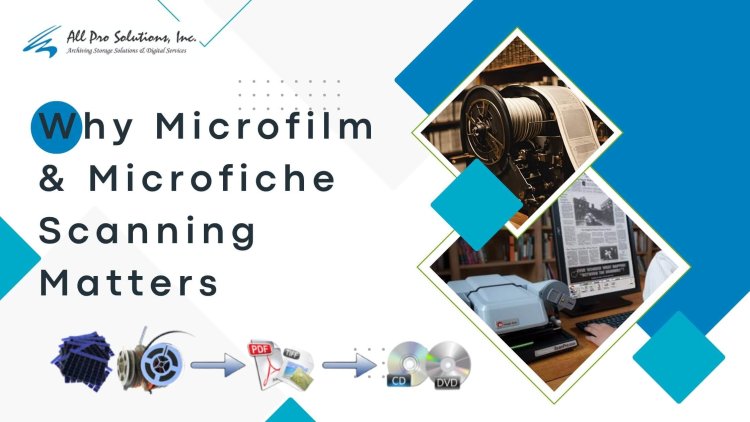Why Microfilm and Microfiche Scanning is Important for Document Preservation
We will explore why microfilm and microfiche scanning is essential for document preservation and how it benefits both organizations and individuals.
Share this Post to earn Money ( Upto ₹100 per 1000 Views )

Preservation of historical documents, legal records, and important data is crucial. For many years, microfilm and microfiche were the gold standard for storing important documents. However, these analogue formats have their challenges, especially in terms of accessibility and longevity. This is where microfilm and microfiche scanning comes into play. In this blog, we will explore why microfilm and microfiche scanning is essential for document preservation and how it benefits both organizations and individuals.
1. Understanding Microfilm and Microfiche
Before diving into the importance of scanning, it is essential to understand what microfilm and microfiche are. Both are methods used to store large amounts of documents in a compact format.
- Microfilm: A reel of film on which images of documents are stored. It has been a popular format for storing newspapers, legal records, and research papers since the early 20th century.
- Microfiche: A flat sheet of film, typically 4x6 inches, that contains tiny images of documents. Libraries, government institutions, and research centres commonly use microfiche to store reference materials.
While these methods were revolutionary at the time, they have their limitations in the modern world.
2. Challenges with Traditional Microfilm and Microfiche
As effective as microfilm and microfiche are, they come with some challenges, especially as technology advances and digital solutions become more prevalent. Some of the major issues include:
- Degradation over time: Microfilm and microfiche are susceptible to deterioration. They can develop scratches, lose clarity, or even become unreadable if not stored under ideal conditions.
- Limited access: Special equipment such as readers and scanners are required to access documents stored on microfilm or microfiche. This equipment is often bulky, outdated, and expensive to maintain.
- Space consumption: Although microfilm and microfiche are more compact than traditional paper files, they still require storage space. As organizations and libraries grow, the space required for these formats can be significant.
- Time-consuming retrieval: Finding specific documents in a reel of microfilm or a sheet of microfiche can be time-consuming. Manual searching slows down processes and efficiency.
These challenges make microfilm and microfiche scanning a vital tool for modern document preservation.
3. Why Microfilm and Microfiche Scanning is Essential
Now that we understand the limitations of microfilm and microfiche, let’s look at why scanning them is important for document preservation.
a. Digital Accessibility and Convenience
The most important advantage of scanning microfilm and microfiche is that it provides digital accessibility. Once scanned, documents are stored in digital formats such as PDF or TIFF, which can be easily accessed on a computer, smartphone or other device.
This means no more bulky equipment or physical archiving – all documents can be retrieved in just a few clicks. This level of convenience saves time and increases productivity for businesses, research institutions and government agencies alike.
b. Enhanced Document Security
Physical storage methods, including microfilm and microfiche, are vulnerable to damage from water, fire or even improper handling. By scanning these materials and converting them into digital formats, organizations ensure a higher level of security.
Digitized documents can be stored in the cloud or on secure servers, protected by encryption and other cybersecurity measures. In the event of a natural disaster, having a digital backup ensures that important documents are never truly lost.
c. Cost-Effective Long-Term Solution
Maintaining microfilm and microfiche requires both physical space and specialized equipment, which can be costly in the long run. By scanning these materials, organizations can significantly reduce storage costs. Plus, once digitized, accessing the data does not require expensive equipment.
d. Improved Longevity and Preservation
Microfilm and microfiche begin to deteriorate over time. Exposure to light, temperature fluctuations, and humidity can cause them to deteriorate. Scanning these materials helps maintain the integrity of documents for future generations. Digital files do not deteriorate as much as physical formats, making them a more durable option for long-term preservation.
e. Easy Document Sharing and Collaboration
In today’s connected world, the ability to share documents instantly is invaluable. Scanning microfilm and microfiche makes it easy to share important files with colleagues, researchers, or clients, no matter where they are. When everything is stored in digital format, it becomes much easier to collaborate on projects involving old archives.
f. Improved Search Capability
One of the most frustrating aspects of using microfilm and microfiche is the time-consuming process of manually searching through reels and sheets to find a specific document. Digital scanning eliminates this hassle.
Once scanned, documents can be searched through optical character recognition (OCR) technology. This means you can search for specific words or phrases within documents, dramatically speeding up the retrieval process. This feature is especially useful for law firms, libraries, and historians who often need to reference specific information from vast archives.
4. The Scanning Process: How It Works
Microfilm and microfiche scanning is a specialized process that involves converting analogue formats to digital. A general overview of how the scanning process works is as follows:
1. Preparation: The microfilm or microfiche is prepared for scanning by cleaning it to remove dust or debris that may affect image quality.
2. Scanning: A high-quality scanner captures each frame or image from the microfilm or microfiche. Images are typically saved in high-resolution formats to ensure clarity and detail.
3. Digital Conversion: After being scanned, the images are converted into digital file formats such as PDF, TIFF or JPEG.
4. Indexing and OCR: After documents are digitized, they can be indexed and processed with OCR software to make them searchable. This allows users to quickly find specific information within digital files.
5. Storage: Finally, digitized documents are stored on secure servers or cloud platforms. Backup copies can be created to ensure the protection of documents against data loss.
5. Industries that Benefit from Microfilm and Microfiche Scanning
Many industries can benefit from microfilm and microfiche scanning, including:
- Libraries and archives: Preserving historical manuscripts, books and newspapers in digital formats for easy public access.
- Law firms: Protecting legal documents, case files and contracts for long-term reference and access.
- Government agencies: Storing vital records, census data and policy documents in secure digital formats.
- Academic institutions: Archiving research papers, dissertations and other academic resources for future generations.
Conclusion: The Future of Document Preservation
In an increasingly digital world, microfilm and microfiche scanning isn’t just a convenience – it’s a necessity. By converting analogue archives to digital formats, organizations ensure that their valuable documents remain preserved for future generations, easily accessible and protected from loss. Whether for historical preservation, legal protection or academic research, the importance of microfilm and microfiche scanning cannot be underestimated.
The shift to digital is inevitable, and embracing this technology is the key to protecting the past while preparing for the future.















